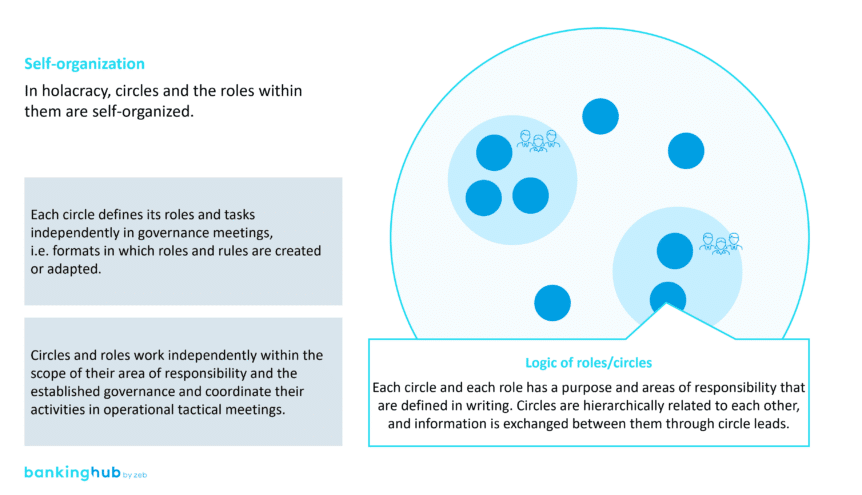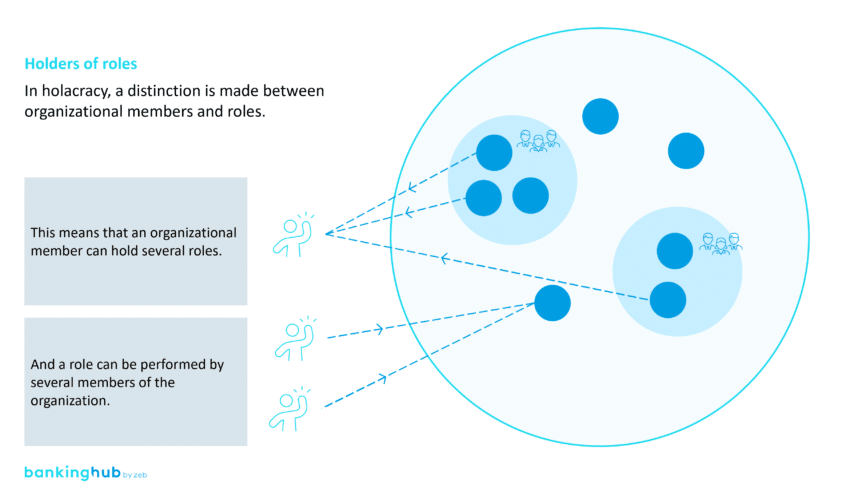Holacracy: an agile framework for modern organizations
Holacracy is an agile organizational framework intended to replace the traditional hierarchical structure with a network of autonomous teams. The term “holacracy” is derived from “holons”, which means autonomous units within a larger whole. The concept of holacracy was first developed by Brian Robertson and Tom Thomison and presented in 2007 in the context of their company “HolacracyOne”.
In contrast to traditional hierarchical models, holacracy promotes the decentralization of decision-making powers and enables teams to react more flexibly to changes. It is based on principles such as self-organization, transparency and continuous improvement.
How does holacracy work?
Holacracy is an organizational structure aiming to overcome traditional hierarchies. The key principles and distinguishing features of holacracy as opposed to traditional organizational structures are as follows:
A) Self-organization and autonomous circles
- Holacracy: In a holocratic structure, organizations are divided into autonomous circles or cells. Each circle has clear responsibilities and decision-making powers as well as a purpose that provides guidance and expresses the overarching goal of the circle. The circles can work and organize themselves independently to achieve their goals.
- Hierarchy: Hierarchical structures by contrast are usually characterized by a clear chain of command. Decisions are delegated from the top down and responsibilities are distributed hierarchically across different levels.
B) Roles instead of positions
- Holacracy: There are no positions in the traditional sense, but roles that are filled based on the skills and experience required. One person can also hold several roles at the same time. A role describes a specific responsibility or function within the organization or within the circle. Within this responsibility, accountabilities are clearly defined and independent of the person currently bearing the responsibility. Roles are regularly checked for the value they add and adjusted if necessary.
- Hierarchy: In hierarchies, individual positions, such as the position of sales manager, are closely linked to the person holding them and are therefore often associated with identification, recognition or prestige. They tend to be stable over time.
C) Dynamic sets of rules instead of fixed hierarchies
- Holacracy: Holacracy is based on dynamic sets of rules, the so-called “holacracy circles”, which can constantly adapt to the changing needs of the organization. These sets of rules define how decisions are made and roles are allocated but can be flexibly adjusted. Decisions are made according to what seems right at the moment based on current information and can also be renegotiated later as soon as objections are made or new information becomes available.
- Hierarchy: Hierarchical structures are often characterized by rigid rank orders in which tasks and responsibilities are defined in positions. Changes usually require a revision of the organizational charts and the entire hierarchy. Once decisions have been made, they are not automatically reopened for discussion if conditions change.
D) Transparent decision-making
- Holacracy: Decisions in holacracy are made and documented in a transparent manner. There are clear processes and mechanisms in place to ensure that the relevant information and the persons responsible are known. This makes it easy to trace decisions. There are two types of meetings: tactical meetings for operational decisions and information, and governance meetings for the further development of the organization.
- Hierarchy: Hierarchical decisions can be more opaque, especially when they are made by managers at the top. The decision-making processes may not be as open and transparent as in a holocratic structure.
Consequently, holacracy aims to be more flexible, agile and adaptable than traditional hierarchical organizational models. However, holacracy is not entirely free of hierarchies: circles and their areas of responsibility are hierarchical, i.e. higher-level circles take on higher-level goals and areas of responsibility and delegate others to lower-level circles.
Circle leads control the flow of information between them. In their leadership function, they set goals and provide the necessary information based on which the roles within the group work independently. Direct management is replaced by clear goals and transparency regarding responsibilities and work statuses.
Advantages of holacracy
Holacracy as an agile organizational framework presents a number of advantages that help to make modern companies future-proof.
- The flexible creation and removal of roles enables organizations to dynamically adapt their structure to the respective requirements.
- The distribution of decision-making powers in the form of roles promotes the self-organization of teams, which leads to greater personal responsibility and an increase in self-starting behavior.
- The clear rules and processes create transparency, allowing employees to better understand how decisions are made and how their roles contribute to the overall goals of the organization.
- The decentralized structure of holacracy helps to encourage innovation by allowing employees to contribute their expertise and creative ideas more effectively and free from hierarchical structures.
- In addition, holocratic organizations are better positioned to adapt to changing market requirements, which leads to competitive advantages.
Limitations of holacracy
Despite these advantages, however, the challenges and limitations of holacracy must also be taken into account.
The implementation of this model often requires a profound cultural change, which can meet with resistance. The structure of holacracy may be too complex for some employees, as it dispenses with clearly defined hierarchies and positions. Resistance to change from existing managers, who may fear a loss of control and authority, can hinder the effective implementation of holacracy. Clear communication is crucial in this context, as misunderstandings can arise if not all team members are fully informed about the principles and processes of holacracy.
Finally, holacracy may not be suitable for every type of organization or industry, as some companies may continue to benefit from traditional hierarchies, depending on their specific needs and ways of working.
Implementing holacracy – also successful in the financial sector
The implementation of holacracy requires a gradual transition and the involvement of all employees. Training courses and workshops as well as the continuous exchange of information on process steps and objectives can help strengthen everyone’s understanding of the new structure and prepare employees for the changes.
In the often traditional and regulated financial industry, holacracy is proving to be an innovative model that meets the requirements of result orientation and adaptability. Companies in this sector, as the example of Hypoport shows, are increasingly relying on holocratic structures in order to be able to react more efficiently to changing market conditions.









